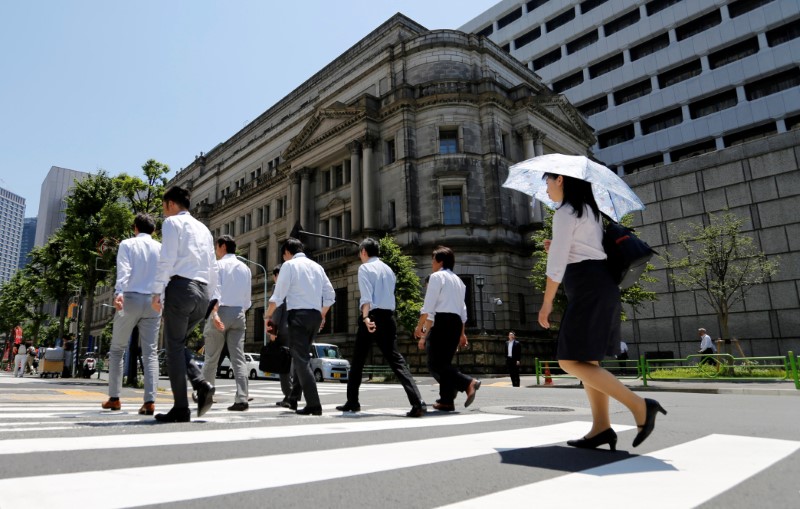 © Reuters. People walk past the Bank of Japan building in Tokyo
© Reuters. People walk past the Bank of Japan building in TokyoBy Leika Kihara
TOKYO (Reuters) – Fears of a global trade war, market volatility and unwelcome yen gains will likely dominate debate at the Bank of Japan’s rate review this week, where policymakers are set to keep monetary policy steady.
BOJ Governor Haruhiko Kuroda rattled markets last week when he said the central bank could consider exiting easy policy if his price target was met in fiscal 2019 as projected.
Kuroda later tempered expectations of a near-term stimulus withdrawal on Tuesday, stressing that debate of an exit won’t happen unless inflation hits the 2 percent goal – a point he will likely to repeat at his post-meeting briefing.
“If achievement of 2 percent inflation is delayed, the start of an exit would be postponed too,” said Hideo Kumano, chief economist at Dai-ichi Life Research Institute.
“Even if the BOJ manages to raise its yield target during fiscal 2019, policy normalization will take a long time.”
At the two-day meeting ending on Friday, the BOJ is widely expected to maintain its massive stimulus program and its projections that the economy is headed for a moderate expansion.
With inflation distant from its target, the BOJ is likely to stress it will keep its money spigot wide open so a tightening job market prompts firms to raise wages, analysts say.
While the rising cost of prolonged easing is drawing calls for debate of an exit strategy, BOJ policymakers see plenty of reasons to stand pat for now.
Global stocks slumped on Wednesday after a key advocate for free trade in the White House announced his resignation, fanning fears President Donald Trump would go ahead with tariffs and risk a trade war.
Escalating trade friction would hurt Japan’s export-reliant economy. Investors’ safe-haven demand pushed the yen near a 16-month high on Wednesday, a move Tokyo policymakers fear could hurt profits and discourage firms from raising wages.
“It’s not an imminent threat to the BOJ’s recovery scenario but risks to look out for,” a source familiar with the bank’s thinking said, a view echoed by two more sources.
The March rate review will be the final one ahead of a BOJ leadership change, which would bring in two new deputy governors who replace incumbents departing on March 19.
The government reappointed Kuroda to serve another five-year term when the current one ends on April 8.
Japan’s economy expanded an annualized 0.5 percent in October-December thanks to robust capital spending, and job losses hit a 25-year low in January reflecting solid growth.
But core consumer inflation remains well below the BOJ’s target, hitting 0.9 percent in January, forcing the bank to keep ultra-loose policy despite the rising cost of prolonged easing.
Fusion Media or anyone involved with Fusion Media will not accept any liability for loss or damage as a result of reliance on the information including data, quotes, charts and buy/sell signals contained within this website. Please be fully informed regarding the risks and costs associated with trading the financial markets, it is one of the riskiest investment forms possible.
Source: Investing.com



























